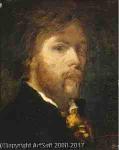Gustave Moreau
Gustave Moreau
Style: Symbolism; Romanticism;
Place: Paris
Born: 1826
Death: 1898
Biography:
Early Life and Education
Gustave Moreau, a French artist, was born on April 6, 1826, in Paris. He received traditional academic training in painting at the École des Beaux-Arts, showcasing an aptitude for drawing from an early age.
The Symbolist Movement
Moreau's work, characterized by allegorical and mythological subjects, positioned him as a leading symbolist painter, especially during the 1890s. His art (and symbolism in general) fell from favor but has been reevaluated since the 1960s, with Moreau now considered among the paramount symbolist painters.
Notable Works and Exhibitions
* Salome at the Prison (Painting by 'Gustave Moreau') is a notable example of his work, showcasing his mastery of Symbolism. * The Self-Portrait (Painting by 'Gustave Moreau') is another powerful representation of the artist himself.
Musee Gustave Moreau
The Musée National Gustave-Moreau (Musée Gustave Moreau Paris, France) in Paris is dedicated to Moreau's work, housing over 1,200 paintings, watercolors, and drawings. The museum is a testament to his artistic legacy.
Legacy and Influence
Moreau's influence on the Symbolist movement is undeniable. He taught at the École des Beaux-Arts, influencing notable artists like Henri Matisse and Georges Rouault. His reclusive nature did not diminish his impact on the art world.
- Discover more about Gustave Moreau's life and work on Wikioo.org
- Explore the Musée National Gustave-Moreau and its impressive collection of artworks on Musée Gustave Moreau Paris, France
- Learn more about the Symbolist movement and its significance in art history on The Symbolism Art Movement
In conclusion, Gustave Moreau's legacy as a seminal figure in the Symbolist movement endures, with his work continuing to inspire and influence artists to this day.
Wikipedia link: Click Here














